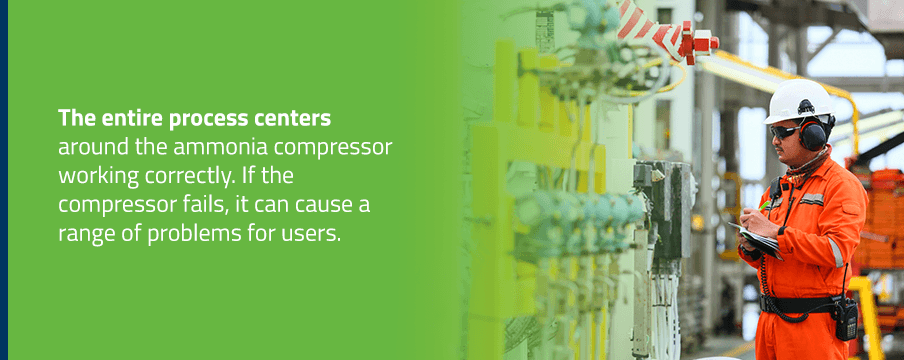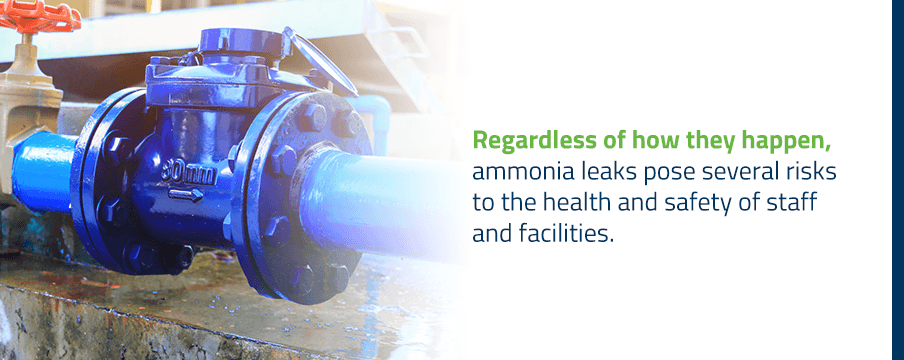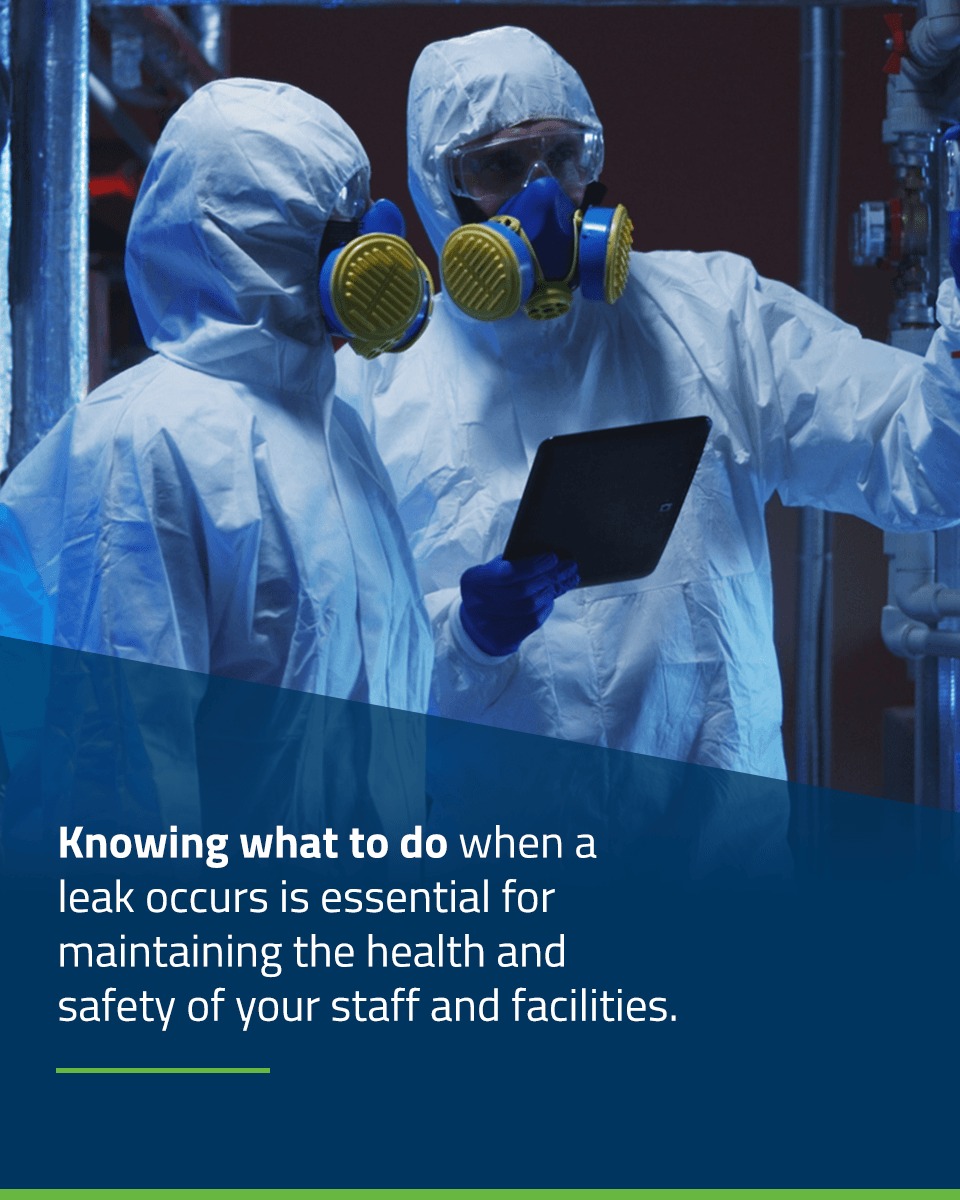Ammonia is an increasingly popular alternative refrigerant to environmentally harmful hydrofluorocarbons. While manufacturers previously avoided ammonia due to its associated health hazards and smells, ammonia has a zero rating for ozone depletion and global warming potential. It also uses less energy than other refrigerant options. Newer technology has made ammonia safe to use as a refrigerant, so it has gained common use in refrigeration equipment like compressors. While ammonia compressors and other ammonia-based refrigeration technologies are highly efficient and effective, the risks of ammonia are still present and must be managed effectively through regular maintenance. In this article, we’ll discuss the basics of how ammonia refrigeration works, the associated risks of poor maintenance and some essential ammonia compressor maintenance tips.
Ammonia Basics
Ammonia, written with the chemical notation of NH3, consists of one atom of nitrogen and three atoms of hydrogen at the molecular level. This colorless yet extremely pungent chemical is commonly found in nature and is an integral part of the nitrogen cycle and biological processes like amino acid synthesis. It is also one of the most widely produced industrial chemicals in the United States, used in industry and commerce. It possesses the following chemical properties:
- Extremely water-soluble
- Readily absorbs moisture from the surrounding environment
- Very alkaline and corrosive
- Easily compressed
Household ammonia is usually a water solution containing only 5 to 10% ammonia. In industrial settings, however, anhydrous ammonia is used. “Anhydrous” is a Greek word meaning “without water,” so anhydrous ammonia consists of at least 99% ammonia. Refrigerant-grade ammonia is at least 99.95% pure ammonia.
How an Ammonia Refrigeration System Works
Anhydrous ammonia is the basis of an ammonia-based industrial refrigeration system. These systems take advantage of the unique chemical properties of anhydrous ammonia, which boils at a temperature of -28°F. Typically, an ammonia compressor cycles through these steps:
- Pressurization: The ammonia compressor pressurizes the ammonia gas, which heats up as the pressure increases. As the ammonia is pressurized, it travels up into the coils at the back of the refrigeration unit, where the heat dissipates.
- Condensation: The pressurized ammonia condenses into a liquid as the heat dissipates, then flows through an expansion valve to a lower-pressure area.
- Expansion: The pressure is released on the other side of the expansion valve, allowing the liquid ammonia to boil and vaporize.
- Cooling: The vaporization of ammonia causes the temperature to drop to anhydrous ammonia’s boiling point at -28°F, cooling the air around it. The cooled air is pushed out of the system into the refrigerated space, and the cold ammonia gas is sucked back into the compressor for the cycle to start over.
This process repeats cyclically to maintain cool temperatures inside the refrigeration system. However, the entire process centers around the ammonia compressor working correctly. If the compressor fails, it can cause a range of problems for users.
Ammonia Leaks and How They Occur
There are many ways in which an ammonia refrigeration system may fail, but one of the most dangerous forThere are many ways in which an ammonia refrigeration system may fail, but one of the most dangerous forms of unit failure is an ammonia leak. Ammonia leaks cause ammonia to leak into the surrounding environment, which can cause a variety of health and human safety problems. The causes of these leaks often come down to poor maintenance but are directly caused by one of the following system problems:
- Excess water: Ammonia refrigeration systems rely on having pure anhydrous ammonia, as impurities can introduce serious problems. Since ammonia is highly water-soluble and easily absorbs water in its surroundings, water is the most common contaminant. Water can enter the system during charging or repair processes where the ammonia is exposed to normal air conditions. Water can also form as part of the normal breakdown of ammonia, though this is a slower process. If water gets into the refrigeration system, it will freeze either on the low-pressure side of the system or in the pipes and valves leading to and from that side. As water freezes, it expands, which can cause these areas to burst, resulting in a leak.
- Excess oil: Impurities in ammonia refrigeration systems may also be caused by excess oil in the system. Oil in the ammonia chambers can cause the system to work harder than necessary to move liquid from the compression chamber. This excess work causes stress on the components of the system, and can result in wear and damage, resulting in a leak.
- Repair and maintenance errors: Irregular maintenance or faulty repair processes may also result in leaks. Maintenance needs to occur every six months at a minimum, and lengthy periods of neglect can result in components wearing down over time. On the other hand, neglectful repairs may result in loose connections, missing caps and other problems, all of which can result in an ammonia leak.
These problems can result in leaks occurring at any point in the system, including in and around valves, pipes and compressors. Wherever the leaks occur, they present an immediate and concerning danger to ammonia compressor integrity and should be addressed as quickly as possible.
Risks of Ammonia Leaks
Regardless of how they happen, ammonia leaks pose several risks to the health and safety of staff and Regardless of how they happen, ammonia leaks pose several risks to the health and safety of staff and facilities. Depending on your industry and applications, there may even be regulations outlining compressor care and how you should address challenges. Some of the most significant effects of ammonia include the following:
- Corrosion: Ammonia can react with and corrode copper, zinc, and many alloys that contain these metals. These negative effects are only enhanced when ammonia is in the presence of moisture. When ammonia leaks directly affect water supplies, this can result in significant damage to piping and equipment.
- Flammability: While anhydrous ammonia is classified as a non-flammable substance, high concentrations of ammonia vapor in the air will burn very easily. This fire hazard is only increased by the presence of other combustible materials. Especially dangerous is the presence of mercury around an ammonia leak, as the two elements can combine to form an unstable explosive compound.
- Human health: Ammonia is not considered poisonous, but it is a significant irritant. Even when exposed to small concentrations, people may experience significant irritation of the eyes, lungs and skin. In higher concentrations, it may result in coughing, congestion and difficulty breathing. When in direct contact with the skin, anhydrous ammonia may cause the skin to freeze-dry. If leaks result in ammonia getting into food, it can result in the ingestion of ammonia, which can cause burns in the mouth, throat and stomach.
For these reasons, it is essential to keep up with ammonia safety standards and implement safeguards to prevent leaks. This includes regular, comprehensive evaluations from an experienced professional.
How to Manage Ammonia Compressor Risk
A facility manager caA facility manager can manage the risk of an ammonia compressor in several different ways. While some adjustments should only be made by or under the supervision of a professional, other general maintenance and quick fixes can be handled by staff with the proper training. Protect and prepare your employees for anything with these tips:
- Know the symptoms and signs of a leak: All employees working around ammonia refrigeration units must be aware of the signs and symptoms of ammonia leaks. They should specifically be aware of any irritation of the eyes and skin, as these are common ammonia leak symptoms. Maintenance personnel should also be aware of system indicators, such as unusually low levels of refrigeration fluid.
- Train your staff: Likewise, all workers should also be trained on staff decontamination procedures for ammonia, which includes flushing affected areas and removing contaminated clothing. In situations involving an ammonia leak, every second counts, and the leak or error must be addressed as quickly as possible for the safety of your entire operation. By training all employees in these essential operations, anyone can address equipment malfunctions and keep your operation moving to the next project.
- Implementing leak detection systems: Even if your entire staff knows what to look for, sometimes the leak is too small or in an unexpected area, preventing immediate detection and costing you in the long term. An ammonia alarm system can keep an eye on your equipment 24/7 and alert you immediately to ammonia leaks anywhere in your system, allowing you to address them sooner.
- Schedule regular maintenance: Preventive maintenance is the single most important process for protecting your equipment. Scheduling maintenance is another way to detect leaks and other concerns as soon as they appear rather than waiting and letting the issue compound until it’s too large to ignore. By then, you may face significant delays in your operations, losses in efficiency and expensive repairs.
- Control irritant exposure: As soon as a leak is identified, work quickly to minimize exposure. Remove all personnel from the area for decontamination and ventilate the room. As soon as the room is cleared, send in personnel with protective clothing and equipment to shut the system off and manage the leak.
- Keep up with the latest codes: Technology and safety standards are continually changing, so it is vital to keep up to date on the latest news and codes regarding ammonia safety. Regularly check in with regulatory agencies and guidelines for ammonia refrigeration and train employees on industry standards and updates.
- Have an emergency response plan: If your facility uses ammonia in any capacity, you must have an emergency response plan for ammonia leaks. This plan should have clear instructions on how personnel must react in the event of a leak and how to stop or control the flow of ammonia. This plan should be as detailed as possible, with diagrams of the refrigeration system, directions for decontamination, and explanations of how to use protective clothing. This emergency response plan should also be easily accessible for review and regularly updated to meet current safety standards and facility technology. You should also be in contact with services to help you manage damage in the event of a leak — for example, at Chardon Laboratories, our water treatment services can help mitigate the damage if ammonia leaks into your water systems.
Knowing what to do when a leak occurs is essential for maintaining the health and safety of your staff and facilities. However, the most important way to manage ammonia compressor risks is to complete regular preventive maintenance on ammonia refrigeration systems. Regular maintenance can catch potential problems before they develop into full-blown leaks. Maintenance procedures can also catch small leaks before they cause damage to staff and facilities.
Ammonia Compressor Maintenance Tips
All mechanical equipment requires regular service, and ammonia compressors are no different. All mechanical equipment requires regular service, and ammonia compressors are no different. Maintenance is a key step in preventing ammonia leaks from happening, so it is essential to keep up with it. Below are some basic ammonia compressor maintenance tips and processes to complete every six months:
- Have two operators: Be sure that two people are present whenever the ammonia chiller system is opened — many compliance programs require this. This will help you address concerns more efficiently and ensure there is backup if an operator requires it.
- Check electrical connections: Go through the system and ensure that electrical connections are firmly in place. While doing so, check for frayed or corroded wiring or connections and replace anything that is damaged. Also, inspect electrical components for wear, pitting or discoloration and clean or replace them depending on the level of damage.
- Check control system operation: Check the pressure, safety and temperature controls to ensure that all setpoints are correct and all components are functioning properly.
- Check refrigerant line insulation: Refrigerant insulation should be free of damage or tears to function properly. If you notice any signs of tears, waterlogging or other forms of damage, replace the affected insulation.
- Check refrigerant levels: Observe the liquid to ensure that it is clear and meeting sufficient levels. If liquid levels are low, this indicates a need to charge the system. If levels are unexpectedly low, this could indicate a system leak.
- Check system superheat: Check the suction superheat at the compressor by measuring suction pressure and temperature. The superheat is the saturated temperature subtracted from the suction line temperature. If the superheat is too low, liquid may be returning to the compressor, causing oil dilution and valve failure. If the superheat is too high, excessive discharge temperatures may cause oil to break down and components to fail. The best option is to keep the superheat as low as possible without damaging system components. You can determine this level by checking manufacturer specifications or consulting with an ammonia compressor specialist.
- Clean the system twice a year: Ammonia systems require smaller volumes of water, but need to be in contact with the air to cool. As a result, the water in the system will look dirtier than a normal system. As a result, it is essential to clean the tower and system twice annually. Be sure not to use chlorine for cleaning and instead use a non-chlorine-based biocide.
- Have an on-call professional: Many issues with ammonia compressors should be handled exclusively by compressor experts. Whether you keep one on staff or you rely on a third-party service provider, make sure you have a trusted professional who can respond at a moment’s notice to keep your staff safe and maintain site efficiency.
When Do You Need Ammonia Compressor Maintenance?
In most cases, regular preventive maintenance once or twice a year is enough to keep your ammonia compressor running smoothly. Still, some aspects of an ammonia system should be monitored continuously to determine if additional maintenance is required. These issues may indicate blockages or failing control systems:
- System skin temperature: Skin temperature higher than 180°F can indicate that the system isn’t cooling properly.
- Head pressure: High head pressure can indicate gas buildup, which can also cause the system not to cool properly.
- Proper flow: It is crucial for the system to maintain adequate flow. Monitor the spray from the tower nozzles to avoid heat differentiation on the coils.
If you notice problems with your compressor that you are unsure of how to fix, contact your manufacturer or a specialist in ammonia compressor maintenance to assist you.
Contact Chardon for More
Ammonia refrigeration systems are highly efficient and effective, playing significant roles in the food production industry. However, that efficiency comes with risks. From flammability and corrosion to human health issues, ammonia leaks can cause significant harm to staff and facilities. To keep your employees and locations safe and maximize the efficiency of your ammonia refrigeration systems, you need an effective maintenance plan backed by specialists who can help you in the event of a leak. Chardon can help.
At Chardon, we specialize in water treatment and can help your company manage ammonia contamination events quickly and efficiently. We know how important ammonia refrigerators are for industry, and can develop solutions for you in the event of a leak. Our ISO-certified water technicians will work with you to develop a specialized water treatment plan for your facility.
If you have any questions about ammonia compressor maintenance or how Chardon’s water treatment solutions can help your company, contact the experts at Chardon today.
Matt Welsh
Matt Welsh is the Vice President and Water Consultant at Chardon Labs. He helps consult a wide range of customers utilizing various methods of water treatment, from chemical to chemical-free approaches, large and small applications, and across a wide range of geographical influences. With 20 years of water treatment experience, including a wide range of troubleshooting and service in potable water and non-potable HVAC and industrial applications, he is an expert in water treatment chemistry for cooling towers, boilers, and closed-loop systems.


